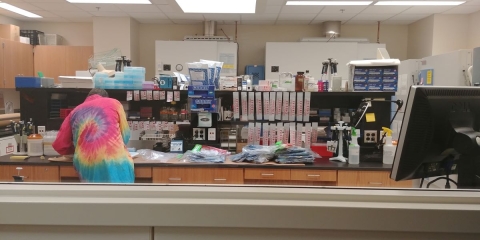
1490 E Main Street
Ashland, OR 97520
United States
About Mary Burnham Curtis
Mary Burnham Curtis has been a senior forensic scientist at the U.S. Fish and Wildlife Service National Fish and Wildlife Forensics Laboratory in Oregon since 2001. She first became genetics team supervisor and then, in 2021, forensic science branch chief. She began her career at the U.S. Fish and Wildlife Service National Fisheries Center-Great Lakes as a fishery biologist trainee working toward her PhD through what is now the Pathways Program. She was the full-time lead for the development of genetics capabilities at Great Lakes Fishery Center through its conversion to the U.S. Geological Service’s Great Lakes Science Center in 1996.
How would you describe your job to someone you just met?
“My team and I conduct forensic genetic analyses for species, population, and individual identification of a diverse array of fish, mammals, birds, herps [amphibians and reptiles], and invertebrate evidence in wildlife investigations. Forensic genetic analyses are important for the prosecution of wildlife crimes where identification of the correct species or individual is a crucial component of the investigation.”
What do you love about the job?
“My favorite part of this job is finding answers to interesting questions about species identification and population genetics. Sometimes they are complex when they involve species we’ve never worked with before, or involve intricate taxonomic relationships. Solving these kinds of puzzles is the best part of the job!”
What skills must you have to succeed at your job?
“A working knowledge of principles of evolution and population genetics, and the ability to quickly tap into your particular scientific education and experience to develop novel approaches to species-identification questions.”
What is your most memorable moment from the job?
“I coordinated a method to use population genetic data to match bald and golden eagle feathers back to eagle carcasses found by Office of Law Enforcement agents. In a recent case called Operation Dakota Flyer, I identified dozens of individual eagles in seized evidence that could be matched back to suspects and crime scenes.”
What led to your career choice?
“I’ve wanted to be a scientist since I was in grade school. My favorite family trips were to the Museum of Science and Industry and the Brookfield Zoo near Chicago. In college, I considered medical school but realized that was not my passion after I was introduced to fisheries biology by an undergrad advisor.”
What is your educational background?
Bachelor of arts in zoology from DePauw University
Master of science in ecology and evolutionary biology from University of Michigan
PhD in ecology and evolutionary biology from University of Michigan
What is your cultural, historical and/or ancestral background? How has this informed your work?
“My dad’s family dates to a shipwreck on the coast of Maine in the late 1600s, and my mom’s family were immigrants from Belgium in the 1900s. Our extended family is full of educators, artists, and a few scientists — a veterinarian and several nurses and me. We’ve always been encouraged to follow our passions.”
What does conservation mean to you?
“Conservation is both a practical and spiritual concept. In practice, it’s a way of making sure that the resources we enjoy can be preserved for future generations. Great examples of the conservation ethic as a spiritual concept are in indigenous cultures— the people who are most passionate about conservation carry that kind of attitude towards their work as well.”
To find available forensic scientist jobs, go to USAJobs.gov. Search “0401,” “biological sciences,” “0486,” “wildlife biologist,” or “forensic.” Filter by “U.S. Fish and Wildlife Service” or “Department of the Interior.” The job requires a bachelor’s degree in biological science with specialized study related to wildlife biology, animal ecology, zoology, botany and a range of other relevant fields. Details about education and experience requirements.
